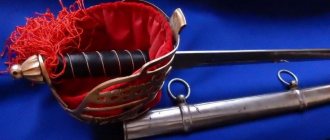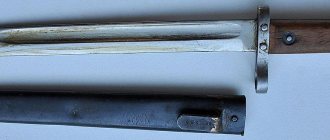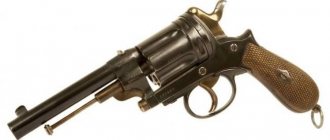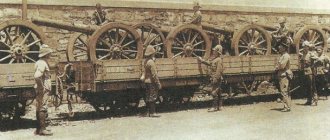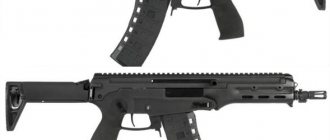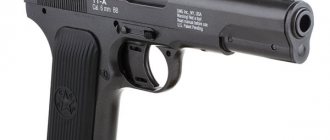In those ancient times, when edged weapons reigned supreme on the battlefields, human thought, in search of new ways to destroy their own kind, created a broadsword - something between a sword and a saber. Its straight, sometimes double-edged, blade struck the enemy so effectively that for many centuries it was in the arsenals of most European and Asian states.
Artifacts from ancient graves
The earliest examples of broadswords were discovered in the burials of the Proto-Bulgarians, a people of Turkic origin who inhabited the steppes of South-Eastern Europe in the 4th and 5th centuries. Despite such a distant era, it had all the same characteristic features that it has retained to this day.
It was a cutting-and-piercing weapon with a straight, double-edged blade, up to a meter long, a hilt designed to protect the hand, and a slightly curved handle. It is known that the same or very similar broadswords were used at that time by the Khazars, Avars, Alans and a number of other representatives of ancient peoples.
The most common myths about swords
Myth 1. The European sword was heavy; in battle it was used to inflict concussion on the enemy and break through his armor, like an ordinary club. At the same time, absolutely fantastic figures for the mass of medieval swords are voiced (10-15 kg). This opinion is not true. The weight of all surviving original medieval swords ranges from 600 grams to 1.4 kg. On average, the blades weighed about 1 kg. Rapiers and sabers, which appeared much later, had similar characteristics (from 0.8 to 1.2 kg). European swords were convenient and well-balanced weapons, effective and convenient in battle.
Myth 2. Another myth about medieval swords is the opinion that they do not have a sharp edge. It is stated that against the armor the sword acted like a chisel, breaking through it. This assumption is also not true. Historical documents that have survived to this day describe swords as sharp weapons that could cut a person in half.
In addition, the very geometry of the blade (its cross-section) does not allow sharpening to be obtuse (like a chisel). Studies of the graves of warriors who died in medieval battles also prove the high cutting ability of swords. The fallen were found to have severed limbs and serious chop wounds.
Myth 3. “Bad” steel was used for European swords. Today there is a lot of talk about the excellent steel of traditional Japanese blades, which are supposedly the pinnacle of blacksmithing. However, historians absolutely know that the technology of welding various types of steel was successfully used in Europe already in antiquity. The hardening of the blades was also at the proper level. The technologies for making Damascus knives, blades and other things were also well known in Europe. By the way, there is no evidence that Damascus was a serious metallurgical center at any time. In general, the myth about the superiority of eastern steel (and blades) over western steel was born back in the 19th century, when there was a fashion for everything eastern and exotic.
Myth 4. Europe did not have its own developed fencing system. What can I say? You should not consider your ancestors more stupid than you. The Europeans waged almost continuous wars using edged weapons for several thousand years and had developed military traditions, so they simply could not help but create a developed combat system. This fact is confirmed by historians. A large number of different fencing manuals have survived to this day, the oldest of which date back to the 13th century. Moreover, many of the techniques from these books are more designed for the dexterity and speed of the fencer than for primitive brute strength.
Weapons of the peoples of the Caucasus
They were also widely used in the Caucasus and the Middle East. A common feature of broadswords made by eastern gunsmiths was weak hand protection. The hilt did not yet have the complex design that would be characteristic of Western European designs of a later period, and, as a rule, consisted only of a crosspiece with an arc.
Among the broadswords that the peoples of the Caucasus armed themselves with are the so-called franguli. They were common among the Khevsurs, an ethnic group that inhabited the basin of the Khevsur Aragvi River and the upper reaches of the Argun. Their handles and scabbards were bound with brass or iron plates and richly decorated with patterns in the national style. Broadswords were also widely used in Georgia. Their special feature was handles similar in appearance to those that could be seen on cavalry sabers at a later time.
Broadswords made by Indian craftsmen
The broadsword was also a very popular weapon in India. Here its design had its own characteristic features, the main of which was the shape of the blade. With a length of about eighty centimeters and sharpening on one side, it was forged with some expansion towards the end, which had an oval shape. In addition, its unique feature was the powerful hilt that reliably protected the hand, consisting of two bowls connected to each other by a steel strip. This design was called kunda.
During the period dating back to the late Middle Ages, another type of broadsword, called firangi, appeared in India. Its originality lay in the blade, which had a one-and-a-half sharpening, that is, on the back side sharpened to half, and the basket hilt, which had a sharp spike, which also served to defeat the enemy.
Spreading
Would our reader become a pirate?
Of course! No, I respect the law.
The wide popularity of the cutlass comes from the name itself.
That is, where pirates or marines meet, and in general, where there is a sea, such a product was distributed there. These are countries such as England, Spain, the Caribbean islands and others.
Such sabers could often be found in Tortuga, where the legendary pirate state of filibusters was located. The indigenous population widely used such a saber. Even for purely economic and peaceful purposes.
With its help, they cut through dense thickets and finished off prey while hunting.
And they even chopped wood. Therefore, a cutlass is often compared to a machete. And they even argue that the saber is the progenitor of the machete.
The first examples of Western European broadswords
In Western Europe, this type of weapon appeared relatively late - in the 16th century, but was immediately appreciated and became widespread. In the forties, the Hungarian hussars began to use a broadsword as a complement to the traditional saber of that time.
The weapon was attached near the saddle and was used mainly for stabbing, which was very convenient thanks to the long blade. At the same time, the design of the handle, somewhat curved and reminiscent of a saber, made it possible to deliver powerful chopping blows.
At the end of the 16th century, a tangible impetus for the further spread of broadswords was the appearance in Western Europe of regular heavy cavalry units - cuirassiers. An indispensable element of their defensive weapons was a metal breastplate - a cuirass, which reliably protected against saber strikes, but was vulnerable to a heavy and long blade, which was equipped with a specially designed type of weapon, which went down in history as the cuirassier broadsword.
Video
A broadsword, a cutting and piercing bladed weapon with a long blade, single- or double-sided sharpening, originated from the medieval sword. The name of the weapon has Turkish roots and is translated as sword or dagger.
The broadsword differs from its ancestor, first of all, in its developed guard with arches and protective cup, which in later types of this weapon most often has a basket shape. The main difference from the sword that appeared later is the wider and thicker blade and, as a result, the greater weight of the weapon. This is a fairly popular form of European swords from the late 15th to early 16th centuries. Here are some popular broadswords from European countries of this period:
- spada schiavona (Spain, translated as “Slavic sword”);
- broadsword (England and Scotland, translated as “basket sword”);
- reiterschwert (Germany from the 16th to the 17th centuries, translated as “horseman’s sword”);
- kurassierdegen (Germany XVIII - XIX centuries, translated as “cuirassier sword”);
- dragonerdegen (Germany XVIII - XIX centuries, translated as “dragoon sword”);
- kavalleriedegen (Germany XVIII - XIX centuries, translated as “cavalry sword”).
All of these variants of edged weapons have characteristic structural features of the blade and handle and are identified as broadswords.
New product from Scottish gunsmiths
Around the same period, Scotland made its contribution to the creation of edged weapons. In it, the so-called Scottish broadsword was created and subsequently became popular throughout Great Britain. If its wide, double-edged blade was generally similar to those with which swords were equipped, then the guard, the part of the hilt that protects the warrior’s hand, was something new.
It was quite large in size and looked like a basket with a significant number of branches. Its inner surface was trimmed with leather or red velvet. In addition, the hilt was decorated with horsehair tassels. The Scottish broadsword was usually used in conjunction with a small round shield. This combination made it possible to conduct both defensive and offensive battles.
Haudegen
The Haudegen (English Mortuary sword, German Haudegen) is a heavy cavalry sword used since the 1620s by cavalry throughout Europe, especially in England. The blade often had a one-sided sharpening and a length of at least 900 mm. The guard does not have a cross, but the basket is clearly defined. The handle is often very intricately decorated. Haudegen weighed between 1100-1200 grams.
12. Pokoinitsky sword (broadsword), England, 17th century. He's gorgeous!!
13.
14.
15. Next are some beautiful handles of other bladed weapons. Court “bump” sword in the diamond-cut style
16. Rapier with a closed hilt inlaid with silver. The blade was made in Solingen around 1610. The handle in Milan - around 1610-1615.
17.
The next two beauty ambassadors amazed me. Very beautiful and delicate work.
18.Chopard created a unique sword for the French-Russian prose writer Andrei Makin, who was elected to the French Academy in March 2016 for his contribution to the development of the French language. The unique sword was created in close collaboration with the academician and embodied the motifs of winter - Makin’s favorite time of year. 11 Chopard craftsmen worked to create this work of art. The silver handle of the sword is made in the form of an intertwined rope, and the handle is completed by a small figurine of the fairy-tale Frog Princess, decorated with 500 tiny emeralds. The inside of the handle is made in the shape of an hourglass made of quartz and complemented by yellow gold balls, the movement of which is meant to remind of the passage of time. The unification of Russian and French cultures is indicated by the letter F engraved on the guard in Cyrillic and Latin script. The guard is made in the form of parchment pierced with a feather.
19. Sword of honor, awarded to Monsieur L. de Tanlay, Prefect of the Somme, by the Association of Antiquaries of Picardy, April 1854. Dimensions: overall length 887 mm, blade length 748 mm, blade width 18.5 mm, scabbard length 785 mm, diameter of large medal 50.5 mm, diameter of small medals 33.5 mm. Material, technique: steel, silver, wood, leather, velvet; forging, casting, carving, etching, stamping. The blade is made of Damascus steel, straight, double-edged, with a rhombic cross-section. The silver hilt of artistic work consists of a handle and a guard.
Walloon swords
Researchers believe that the Western European broadsword is a weapon resulting from the transformation of a previously existing heavy cavalry sword, which was called a saddle sword, since it was usually attached to the saddle. In this regard, broadswords were initially called Walloon swords, after the name of the region of Belgium where this type of weapon was produced. Their characteristic feature was somewhat asymmetrical hilts, which reliably protected the warrior’s hand thanks to a bowl equipped with numerous arches and a transverse crosspiece.
New times - new trends
In the 17th century, the armies of most European states underwent a process of unification of weapons. At first, individual regiments and squadrons, and then entire types of cavalry, were brought to a single standard. From that time on, the broadsword, a weapon that had previously been used by all cavalry without exception, became part of the arsenal of only dragoon and cuirassier units.
By the middle of the 18th century, the design of the blade changed. The double-edged blade was replaced by a blade sharpened only on one side and having a blunt edge. Only its shape and size remained the same, at which it remained a fairly powerful and heavy weapon.
Schiavona
SCHIAVONA (Italian schiavona - Slavic, Slavic) is a type of straight sword of the Renaissance era with a basket guard. The very name of this type of sword is medieval jargon, which migrated first into everyday use of its time, and then into scientific terminology. It is simply translated: Slavic. Without a doubt, this is an abbreviation for the descriptive La espada schiavona - Slavic sword (in Italian the sword is feminine). It can be literally translated into Russian as Slavyanka, as in the famous portrait of Titian from 1508-10. from the British National Gallery, London “Portrait of a Lady” (La Schiavona). The hilt of these swords has a square or rectangular pommel with a rounded protrusion in the center. The crosshair is often bent horizontally, and sometimes this is done so dashingly that it resembles the number “eight”. Guards of this type can be traced in Hungarian swords of the 14th-15th centuries.
8.
9.
10.
11.
Boarding party weapons
For three centuries, from the 16th to the 19th centuries, the broadsword was used not only on land, but also at sea. It was an integral part of the weapons of the boarding teams - those dashing thugs who, having dragged the side of the enemy ship with steel hooks, rushed into hand-to-hand combat. The boarding broadsword differed from its land counterpart, first of all, in that its guard was made in the form of a shell.
There were other differences as well. Its one-sided blade, which had a length of up to eighty centimeters and a width of about four centimeters, was devoid of fullers - longitudinal channels designed to reduce weight and give additional strength. In this respect, the naval broadsword was similar to the infantry one, which had the same design feature of the blade.
Cavalry statutory weapons
The end of the 17th century was marked by the fact that regulations began to be introduced in the armies of European countries, assigning a certain type of weapon to each branch of the military. For heavy cavalry, the broadsword becomes such a statutory weapon.
For all branches of cavalry troops there were their own types of these swords: dragoon broadswords, cuirassier broadswords, even guards versions of this sword that differed from the general army variants. What they had in common was that they were heavy piercing and chopping blades with one-sided or one-and-a-half sharpening and a pronounced edge.
These weapons were mass-produced in most major weapons centers in Europe. Since the quantity of weapons produced was enormous, and the details of appearance and functional characteristics were strictly regulated by the branch of the military for which they were intended, many typical examples of authorized weapons have been preserved. Thanks to this, a modern fan of edged weapons can imagine in detail, for example, a 19th century cuirassier broadsword.
Broadsword: history of origin as a link in the chain of development of medieval swords
Broadswords in the Russian army
The broadsword appeared in Russia at the end of the 17th century. This was due to the large influx of foreign officers into military service, who, as a rule, brought firearms and bladed weapons with them. The photo that concludes the article shows several broadswords of that period, made in Moscow, but made according to foreign models. As you can see, they are characterized by a beveled handle, convenient for delivering slashing blows from a horse, as well as a cross, straight or with ends lowered to the blade.
In the first quarter of the 18th century, under Peter I, dragoon regiments were created everywhere in the Russian army as one of the most effective types of heavy cavalry. The main component of their weapons was the broadsword - the weapon most suitable for this type of army. The demand for it increased sharply, since, in addition to dragoon units, horse-grenadier and carabinieri regiments were armed with it.
Production and import of broadswords
From that time on, they began to produce it using the factory method, introducing a certain unification, but, in addition, a significant number of broadswords were delivered from abroad. In Western Europe, the main center of their production was the German city of Solingen, where by that time there were a number of enterprises specializing in the production of edged weapons.
Broadswords produced in Russia had a number of distinctive features. For example, products produced during the reign of Empress Catherine II were decorated with an engraving depicting a crown and its monogram - “E II”. The sheath was leather or made of wood and covered with leather. This tradition continued until 1810, when, by order of Alexander I, they began to be made of metal. The only exception was the boarding broadsword, whose sheath still remained leather.
The broadsword as an independent type of bladed weapon became most widespread in the first half of the 19th century. At this time, several of its varieties were in service with the Russian and most European armies. Among them, researchers highlight: the guards cuirassier broadsword, the army cuirassier broadsword, the dragoon broadsword and, finally, the infantry broadsword. Each of these types has its own characteristic features. Their common feature was the design of the blade, which became single-edged from the beginning of the 19th century.
Sword typology
Back in 1958, edged weapons expert Ewart Oakeshott proposed a taxonomy of medieval swords that remains basic to this day. This taxonomy is based on two factors:
- Blade shape: its length, width, tip, general profile.
- Sword proportions.
Based on these points, Oakeshott identified 13 main types of medieval swords, ranging from Viking swords to late medieval swords. He also described 35 different types of pommels and 12 types of sword crosses.
Interestingly, between 1275 and 1350 there was a significant change in the shape of swords; it was associated with the advent of new protective armor, against which the old-style swords were not effective. Thus, knowing the typology of swords, archaeologists can easily date a particular ancient sword of a medieval knight by its shape.
Now let's look at some of the most popular swords of the Middle Ages.
